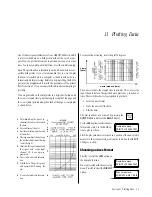
20
Level Setup Procedure
You can use the following procedure to properly set up a pressure
transducer with a level type input channel.
1. Program the transducer parameters of linearity, scale factor, and
offset. Remember to set to zero any parameter not specified.
2. Program the transducer warmup delay. Set it to 50 mSEC if not
specified otherwise.
3. Enter the specific gravity. Make sure it’s set to 1 if you are work-
ing with water.
4. Select the units and level mode you require for the test.
5. Lower the transducer beneath the water surface. Secure it in place
below the lowest anticipated water level, but not so low that the
range of the transducer might be exceeded at the highest antici-
pated level.
6. Connect the transducer to the in-
put channel and use the
READ
option to check the operation of
the transducer.
The reading shown in parenthe-
ses is the transducer head. The
reading to the right is the com-
puted level.
Adjust the transducer setting until the head reading indicates
that the transducer is set at the desired depth. The level reading
should be ignored at this point since we have not yet specified the
reference level.
7. Enter the reference level with the transducer connected and in
position.
8. Repeat the
READ
function and
verify that the level reading now
reads properly.
Programming Flow Types
The flow type input channel measures flow rate indirectly by using a
pressure transducer to measure the pressure behind an orifice plate
at the end of a pipe discharging horizontally into open air.
The parameters for a flow type input
are contained in three menus. Use
the more option to access a deeper
menu. Use
CLEAR
to back up to the
previous menu level.
Three of the menu param-
eters are used to convert the
4-20 mA transducer output
to a pressure in PSI units.
These may be found on the
cable reel, or on a data tag
attached to the cable. Use
the column labeled “Qua-
dratic Coefficients.”
•
LIN
Linearity — Set to zero if not specified by the transducer
manufacturer.
•
SCALE
Scale factor — Set as specified by the manufacturer; this
value should not be zero for a pressure transducer.
•
OFFS
Offset — Set to zero if not specified.
•
DELAY
Warmup delay — For an In-Situ transducer, set to 50
mSEC unless specified otherwise. You will probably have to de-
termine this value by experiment for third-party transducers.
Re-
minder
: During the first ten minutes of log sampling, the HER-
MIT 2000 uses a warmup delay of 50 mSEC, regardless of the
delay programmed. If you’ve selected the log sample mode, make
certain that your transducers are compatible with this require-
ment.
The unit will check that the sum of the delays does not exceed the
selected sample rate. (This is only
likely to be a problem with third-
party XDs and a very fast LIN2 sample
rate.) This error message means you
need to use shorter delays if possible, or a longer sample rate.
The intermediate pressure reading is calculated using the quadratic
formula
P = LX
2
+ SX + O
where
P =
Pressure in PSI
X =
Normalized* transducer value (0-1)
L =
Linearity
S =
Scale factor in PSI full scale
O =
Offset in PSI
*
Transducer reading (in mA) minus 4 divided by 16
Section 5: Setting Up Transducers
Input 2: Level (F)
READ I.D. REF. more
Input 2: Level (F)
(20.672)
-2.900
Input 2: Level (F)
(20.672)
130.900
Input 3: Flow
READ I.D. KxA
more
Input 3: Flow
DELAY SG
Input 3: Flow
LIN SCALE OFFS more
Test 0: DELAYS>RATE!
(cant start/step)
















































